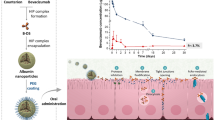Abstract
In vitro and in situ experimental models that are descriptive of drug absorption in vivo are valuable tools in the discovery of new chemical entities that are bioavailable after oral administration. The specific objective of the study was to compare the intestinal permeabilities obtained in the three absorption models for consistency, and to assess the utility of the models in predicting the fraction of dose absorbed in human studies. The intestinal absorption models that were compared are widely used: the rat in situ single-pass intestinal perfusion system, the rat everted intestinal ring method, and monolayers of human colon adenocarcinoma cell line (CACO-2). The models were compared using small molecular reference compounds, as well as a series of peptidomimetic (PM) analogs. Each model had strong potential for estimating the fraction absorbed. For small organic molecules, excellent correlation was observed when permeabilities from CACO-2 cells and perfusions, or everted rings and perfusions, were compared. Weaker correlation was observed between everted rings and CACO-2 cells. Permeabilities for the set of reference compounds and PMs were positively correlated between any two of the three systems. Variance between correlations for reference compounds and PMs are likely due to structural features and physicochemical properties that are unique to the latter class of compounds. The results support caution in extrapolating correlations based on findings with small organic molecules to the behavior of complex peptidomimetics. Corroboration of permeabilities with two methods of determination is a useful cross-validation of experimental systems, as well as producing a reliable permeability assessment. CACO-2 cell monolayers and rat single-pass intestinal perfusion combine the highest correlation between systems, most defined relationship with fraction absorbed in humans, and experimental logistics in-line with discovery candidates.
Similar content being viewed by others
REFERENCES
W.C. Patt, H.W. Hamilton, M.J. Ryan, C.A. Painchaud, M.D. Taylor, S.T. Rapundalo, B.L. Batley, C.J.C. Connolly, D.G. Taylor. A novel orally active renin inhibitor containing 2-amino-4-thiazolyl-alanin at P2 with a long duration of action in a primate model of hypertension. Med. Chem. Res. 2:10–15 (1992).
D. Barlow and T. Satoh. The design of peptide analogues for improved absorption. J. Contr. Rel. 29:283–291 (1994).
P. Artursson and J. Karlsson. Correlation between oral drug absorption in humans and apparent drug permeability coefficients in human intestinal epithelial (CACO-2) cells. Biochem. Biophys. Res. Comm. 175:880–885 (1991).
R.A. Conradi, K.F. Wilkinson, B.D. Rush, A.R. Hilgers, M.J. Ruwart, P.S. Burton. In vitro/in vivo models for peptide oral absorption: comparison of CACO-2 cell permeability with rat intestinal absorption of renin inhibitory peptides. Pharm. Res. 10:1790–1792 (1993).
D.C. Kim, P.S. Burton, R.T. Borchardt. A correlation between the permeability characteristics of a series of peptides using an in vitro cell culture model (Caco-2) and those using an in situ perfused rat ileum model of the intestinal mucosa. Pharm. Res. 10:1710–1714 (1993).
C.-P. Lee, D.C. Chiossone, I.J. Hidalgo, P.L. Smith. Comparison of in vitro permeabilities of a series of benzodiazepines and correlation with in vivo absorption. Pharm. Res. 10:S-177 (1993).
P.S. Leppert and J.A. Fix. Use of everted intestinal rings for in vitro examination of oral absorption potential. J. Pharm. Sci. 83:976–981 (1994).
D.M. Matthews. Intestinal absorption of peptides. Physiol. Rev. 55:537–608 (1975).
P. Artursson, A.-L. Ungell and J.-E. Lofroth. Effective paracellular permeability in two models of intestinal absorption: cultured monolayers of human intestinal epithelial cells and rat intestinal segments. Pharm. Res. 10:1123–1128 (1993).
B.H. Stewart, G.L. Amidon, R. Kaye Brabec. Uptake of prodrugs by rat intestinal mucosal cells: mechanism and pharmaceutical implications. J. Pharm. Sci. 75:940–945 (1986).
H-H. Lu, J. Thomas, D. Fleisher. Influence of D-glucose-induced water absorption on rat jejunal uptake of two passively absorbed drugs. J. Pharm. Sci. 81:21–25 (1992).
G.L. Amidon, P.J. Sinko, and D. Fleisher. Estimating human oral fraction dose absorbed: a correlation using rat intestinal membrane permeability for passive and carrier-mediated compounds. Pharm. Res. 5:651–654 (1988).
P.J. Sinko, M. Hu, G.L. Amidon. Carrier-mediated transport of amino acids, small peptides, and their drug analogs. J. Contr. Rel. 6:115–121 (1987).
S. Lu, A.W. Gough, W.F. Bobrowski, B.H. Stewart. Effect of subculturing on selective properties of CACO-2 cells as a transport model. Pharm. Res. 11:S-258 (1994).
P. Artursson. Cell cultures as models for drug absorption across the intestinal mucosa. Crit. Rev. Ther. Drug Carrier Systems 8:305–330 (1991).
H. Hamilton, B. Steinbaugh, J. Blankley, M. Taylor, O.H. Chan, B. Stewart, R. Schroeder, M. Ryan, S. Rapundalo, J. Cook, A. Bernabei, C. Stewart. Evaluation of the intestinal permeability and hepatic handling of peptidomimetic drugs. Bioorg. Med. Chem. Lett. 3(5):813–818 (1993).
H.W. Hamilton, B.A. Steinbaugh, B.H. Stewart, O.H. Chan, H.L. Schmid, R. Schroeder, M.J. Ryan, J. Keiser, M.D. Taylor, C.J. Blankley, J. Kaltenbronn, J. Wright, J. Hicks, Evaluation of physicochemical parameters important to the oral bioavailability of peptide-like compounds: implications for the synthesis of renin inhibitors. Submitted to J. Med. Chem., 1994.
R.B. Fisher and D.S. Parsons. The gradient of mucosal surface area in the small intestine of the rat. J. Anat. 84:272–282 (1950).
B.H. Stewart, A.R. Kugler, P.R. Thompson, H.N. Bockbrader. A saturable transport mechanism in the intestinal absorption of gabapentin is the underlying cause of the lack of proportionality between increasing dose and drug levels in plasma. Pharm. Res. 10:276–281 (1993).
P.A. Porter, I. Osiecka, R.T. Borchardt, J.A. Fix, C. Gardner. In vitro drug absorption models. II. Salicylate, cefoxitin, α-methyldopa and theophylline uptake in cells and rings: correlation with in vivo bioavailability. Pharm. Res. 2:293–298 (1985).
I. Osiecka, P.A. Porter, R.T. Borchardt, J.A. Fix, C.R. Gardner. In vitro drug absorption models. I. Brush border membrane vesicles, isolated mucosal cells and everted intestinal rings: characterization and salicylate accumulation. Pharm. Res. 2:285–293 (1985).
B.R. Stevens, H.J. Ross, E.M. Wright. Multiple pathways for neutral amino acids in rabbit jejunal brush border vesicles. J. Membrane Biol. 66:213–225 (1982).
C.J. Alcorn, R.J. Simpson, D. Leahy, and T.J. Peters. In vitro studies of intestinal drug absorption. Biochem. Pharm. 42:2259–2264 (1991).
J.E. Haky and A.M. Young. Evaluation of a simple HPLC correlation method for the estimation of the octanol-water partition coefficients of organic compounds. J. Liq. Chromatogr. 7(4): 675–689 (1984).
W.D. Stein, The Movement of Molecules across Cell Membranes, Academic Press, New York, 1967.
O.H. Chan, H.W. Hamilton, B. Steinbaugh, M.D. Taylor, B.H. Stewart. Quantitative structure-absorption relationship in renin inhibitors and structurally related compounds. Pharm. Res. 9:S-347 (1992).
O.H. Chan et al, Absorption of peptidomimetics in rat intestinal perfusion and CACO-2 cell models: impact of selected physicochemical parameters, in preparation, 1995.
R.H. Lu, O.H. Chan, H.W. Hamilton, E.L. Reyner, H.L. Schmid, B. Steinbaugh, B.H. Stewart, Discrimination between intestinal permeabilities of renin inhibitor analogs as a function of lipophilicity and molecular weight using a CACO-2 cell model: comparison with a rat intestinal perfusion model. Pharm. Res. 10:S-179 (1993).
D.A. Johnson and G.L. Amidon. Determination of intrinsic membrane transport parameters from perfused intestine experiments: a boundary layer approach to estimating the aqueous and unbiased membrane permeabilities. J. theor. Biol. 131:93–106.
R.C. Reid, J.M. Prausnitz, T.K. Sherwood, The Properties of Gases and Liquids, McGraw-Hill Book Co., New York, 1977.
Author information
Authors and Affiliations
Rights and permissions
About this article
Cite this article
Stewart, B.H., Chan, O.H., Lu, R.H. et al. Comparison of Intestinal Permeabilities Determined in Multiple in Vitro and in Situ Models: Relationship to Absorption in Humans. Pharm Res 12, 693–699 (1995). https://doi.org/10.1023/A:1016207525186
Issue Date:
DOI: https://doi.org/10.1023/A:1016207525186




